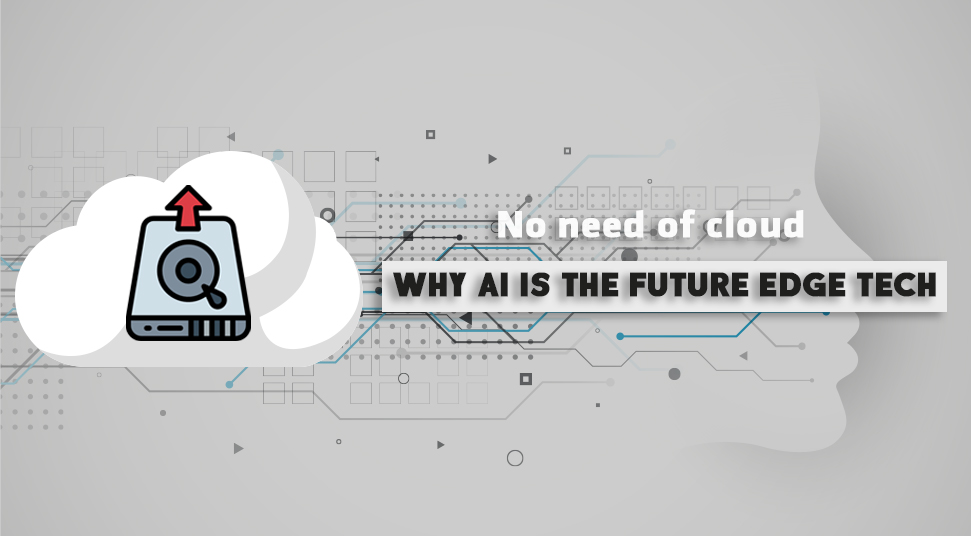
Nowadays, everyone is familiar with the Cloud, isn’t it? Now, imagine Cloud with a touch of Artificial Intelligence applications in it.
AI in Cloud is the hottest news and it is the future edge tech. Companies will now make a profit by securing the best use of AI in the Cloud.
IoT and its application processing requirements shape the Future Edge of technology. Thus, it provides help in promoting the growth of micro modular data centers and raise the question of cloud computing’s importance.
You can use Edge computing as any computing atmosphere located outside a cloud network. This definition is broader in terms and involves various application types.
A good feature of edge computing is that it establishes processing near the source of data instead of performing concentrated processing at a far-away central place.
Looks of AI at the Edge
‘AI at the Edge’ is totally a different concept than the Cloud. Actually, it will consist of many different pictures. Many startups are focussing on producing infrastructure for an AI smart edge.
SWIM.AI is focused on bringing automated AI to the edge. It was commenced on April 4, 2018, and founded by Rusty Cumpston who was the CEO and co-founder of Sensity Systems.
Later, the company sold itself to Verizon. Simon Crosby joined hands with the organization as the CTO who is also the founder of XenSource and Bromium.
By having a glance at what SWIM.AI is up to along with its SWIM EDX item, we can predict how AI will function at the edge.
Hallmarks of EDX:
Artificial Intelligence is the stimulation of human intelligence process by various machines that includes computer systems as well. This also involves learning, reasoning as well as self-correction.
Some of the main principles are stated below to give you a brief of how EDX works:
1. Automated Training and Model Creation:
It is not possible to have data scientists directly to craft models for all the required situations. Each and every equipment is different and requires a huge knowledge of data.
EDX at first studies the data and after that generate a predictive product. It starts with random weights and achieves the same until predictions become absolutely perfect and accurate. The models are constantly refined and purified by the edge data.
2. Requires Continuous Monitoring:
When the assumptions become perfect and accurate, EDX at first displays the outcome to human users for its approval to perform automatic operations. This helps in the inspection of the forecastings before functioning.
3. Uses Full Loyalty Data for Training Purpose:
The EDX training involves a lot of detailed possible data where it is created, closer to the said device. This happens to avoid the cost and complexity of transferring huge quantity of data to the Cloud.
4. Automatic Adaption and Deployment of Systems on Available Infrastructure:
EDX is an organizing and managing software which can easily found out and deployed on available edge computing infrastructure. Thus, it helps in forming a unique compute fabric for multiple devices by not interfering with other important tasks of the devices.
5. Initially, Systems Must Perform in Full Automated Mode:
After primary approval from the users, the device or the system should function automatically for the maximum part. EDX continues training and forecasting future activities completely on the basis of the data streaming via the system.
Additional Facts:
The above principles show how AI will perform at the edge. However, there are several other ways as well.
It is the buyers who make decisions about choosing the infrastructure to fix their problem. The first application of SWIM EDX aimed at improving and making effective municipal infrastructure.
This includes streetlights and traffic control, thus helping in promoting efficiency in industrial manufacturing atmospheres. Hence, promoting and improving functions on networking and IoT areas.
Ending Note
Artificial Intelligence algorithms will acquire many brains functioning together and perform automated work. It will behave just like a human being and will learn from our surrounding local data in order to make optimized decisions.
In addition, AI devices at the edge will direct on its own to the digital algorithm after learning from the surroundings to take a decision which is specific goal-oriented. Thus, investing in IoT devices will prove to be a great opportunity in the near future as AI will store all data in the Cloud.
Despite, all the benefits and excitement of artificial intelligence, there exists one loophole to its popularity. The algorithms used for running AI programs and applications are so large and complicated.
Thus, they need processing on great and powerful machines in the Cloud and data centers. It helps in making a wide usage of AI applications less important on smartphones and other devices which uses edge technology.
Now, this problem is fading as many software in the upcoming months are about to come in the market.
